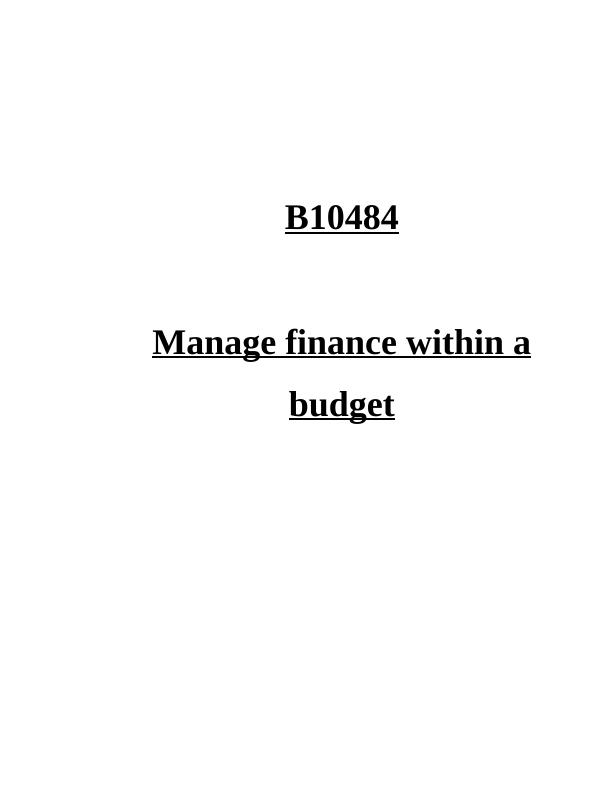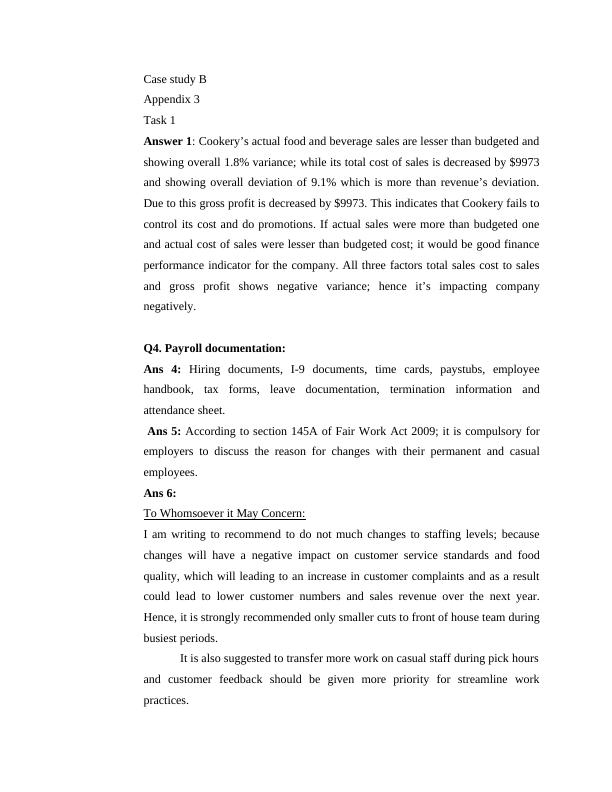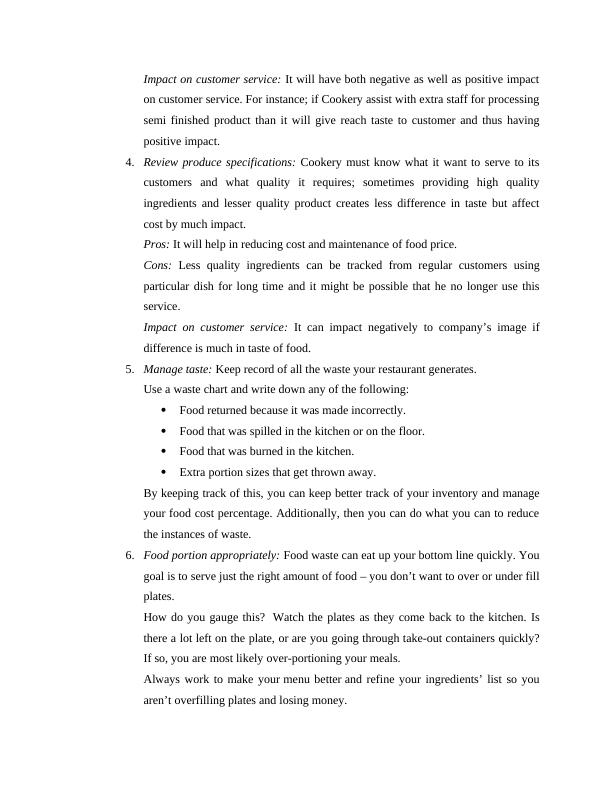Manage Finance within a Budget
Added on 2023-01-12
13 Pages3886 Words25 Views
B10484
Manage finance within a
budget
Manage finance within a
budget

Case study B
Appendix 3
Task 1
Answer 1: Cookery’s actual food and beverage sales are lesser than budgeted and
showing overall 1.8% variance; while its total cost of sales is decreased by $9973
and showing overall deviation of 9.1% which is more than revenue’s deviation.
Due to this gross profit is decreased by $9973. This indicates that Cookery fails to
control its cost and do promotions. If actual sales were more than budgeted one
and actual cost of sales were lesser than budgeted cost; it would be good finance
performance indicator for the company. All three factors total sales cost to sales
and gross profit shows negative variance; hence it’s impacting company
negatively.
Q4. Payroll documentation:
Ans 4: Hiring documents, I-9 documents, time cards, paystubs, employee
handbook, tax forms, leave documentation, termination information and
attendance sheet.
Ans 5: According to section 145A of Fair Work Act 2009; it is compulsory for
employers to discuss the reason for changes with their permanent and casual
employees.
Ans 6:
To Whomsoever it May Concern:
I am writing to recommend to do not much changes to staffing levels; because
changes will have a negative impact on customer service standards and food
quality, which will leading to an increase in customer complaints and as a result
could lead to lower customer numbers and sales revenue over the next year.
Hence, it is strongly recommended only smaller cuts to front of house team during
busiest periods.
It is also suggested to transfer more work on casual staff during pick hours
and customer feedback should be given more priority for streamline work
practices.
Appendix 3
Task 1
Answer 1: Cookery’s actual food and beverage sales are lesser than budgeted and
showing overall 1.8% variance; while its total cost of sales is decreased by $9973
and showing overall deviation of 9.1% which is more than revenue’s deviation.
Due to this gross profit is decreased by $9973. This indicates that Cookery fails to
control its cost and do promotions. If actual sales were more than budgeted one
and actual cost of sales were lesser than budgeted cost; it would be good finance
performance indicator for the company. All three factors total sales cost to sales
and gross profit shows negative variance; hence it’s impacting company
negatively.
Q4. Payroll documentation:
Ans 4: Hiring documents, I-9 documents, time cards, paystubs, employee
handbook, tax forms, leave documentation, termination information and
attendance sheet.
Ans 5: According to section 145A of Fair Work Act 2009; it is compulsory for
employers to discuss the reason for changes with their permanent and casual
employees.
Ans 6:
To Whomsoever it May Concern:
I am writing to recommend to do not much changes to staffing levels; because
changes will have a negative impact on customer service standards and food
quality, which will leading to an increase in customer complaints and as a result
could lead to lower customer numbers and sales revenue over the next year.
Hence, it is strongly recommended only smaller cuts to front of house team during
busiest periods.
It is also suggested to transfer more work on casual staff during pick hours
and customer feedback should be given more priority for streamline work
practices.

With regards
Budget Manager
Case study - A
Ans 1: List of options:
1. Conduct Inventory Consistently: Inventory of food, beverages and serving
supplies should be conducted atleast once per week.
Pros:
It will show how food being used, lost or stolen.
Usage rate will help in deciding menu item costs.
Helps in controlling and maintaining costs.
Cons:
Staff might think that they are not trusted by management.
Impact on customer service:
Customer will be happy to receive food at convenient price as compare to market.
2. Changing supplier: It always cheaper when orders in bulk; but as of food
industry, purchase in huge quantity may not be possible. Hence join a purchase
group can help Cookery to enjoy lower food prices.
Pros: Purchasing in huge quantity provides price advantage to Cookery industry.
Cons: It is not possible that all purchase group chain orders particular item at
single point.
Impact on customer service: Customer will enjoy cheap product nourishing with
good quality products.
3. Do more prep work: Prepared food is more expensive than raw ingredients. For
instance; instead of purchasing chopped lettuce, kitchen department can buy heads
of lettuce and cut by chef itself.
Pros: Buying raw food will help in maintaining overall cost of item.
Cons: Preparing food at own place will increase the time of processing and
requires more staff.
Budget Manager
Case study - A
Ans 1: List of options:
1. Conduct Inventory Consistently: Inventory of food, beverages and serving
supplies should be conducted atleast once per week.
Pros:
It will show how food being used, lost or stolen.
Usage rate will help in deciding menu item costs.
Helps in controlling and maintaining costs.
Cons:
Staff might think that they are not trusted by management.
Impact on customer service:
Customer will be happy to receive food at convenient price as compare to market.
2. Changing supplier: It always cheaper when orders in bulk; but as of food
industry, purchase in huge quantity may not be possible. Hence join a purchase
group can help Cookery to enjoy lower food prices.
Pros: Purchasing in huge quantity provides price advantage to Cookery industry.
Cons: It is not possible that all purchase group chain orders particular item at
single point.
Impact on customer service: Customer will enjoy cheap product nourishing with
good quality products.
3. Do more prep work: Prepared food is more expensive than raw ingredients. For
instance; instead of purchasing chopped lettuce, kitchen department can buy heads
of lettuce and cut by chef itself.
Pros: Buying raw food will help in maintaining overall cost of item.
Cons: Preparing food at own place will increase the time of processing and
requires more staff.

Impact on customer service: It will have both negative as well as positive impact
on customer service. For instance; if Cookery assist with extra staff for processing
semi finished product than it will give reach taste to customer and thus having
positive impact.
4. Review produce specifications: Cookery must know what it want to serve to its
customers and what quality it requires; sometimes providing high quality
ingredients and lesser quality product creates less difference in taste but affect
cost by much impact.
Pros: It will help in reducing cost and maintenance of food price.
Cons: Less quality ingredients can be tracked from regular customers using
particular dish for long time and it might be possible that he no longer use this
service.
Impact on customer service: It can impact negatively to company’s image if
difference is much in taste of food.
5. Manage taste: Keep record of all the waste your restaurant generates.
Use a waste chart and write down any of the following:
Food returned because it was made incorrectly.
Food that was spilled in the kitchen or on the floor.
Food that was burned in the kitchen.
Extra portion sizes that get thrown away.
By keeping track of this, you can keep better track of your inventory and manage
your food cost percentage. Additionally, then you can do what you can to reduce
the instances of waste.
6. Food portion appropriately: Food waste can eat up your bottom line quickly. You
goal is to serve just the right amount of food – you don’t want to over or under fill
plates.
How do you gauge this? Watch the plates as they come back to the kitchen. Is
there a lot left on the plate, or are you going through take-out containers quickly?
If so, you are most likely over-portioning your meals.
Always work to make your menu better and refine your ingredients’ list so you
aren’t overfilling plates and losing money.
on customer service. For instance; if Cookery assist with extra staff for processing
semi finished product than it will give reach taste to customer and thus having
positive impact.
4. Review produce specifications: Cookery must know what it want to serve to its
customers and what quality it requires; sometimes providing high quality
ingredients and lesser quality product creates less difference in taste but affect
cost by much impact.
Pros: It will help in reducing cost and maintenance of food price.
Cons: Less quality ingredients can be tracked from regular customers using
particular dish for long time and it might be possible that he no longer use this
service.
Impact on customer service: It can impact negatively to company’s image if
difference is much in taste of food.
5. Manage taste: Keep record of all the waste your restaurant generates.
Use a waste chart and write down any of the following:
Food returned because it was made incorrectly.
Food that was spilled in the kitchen or on the floor.
Food that was burned in the kitchen.
Extra portion sizes that get thrown away.
By keeping track of this, you can keep better track of your inventory and manage
your food cost percentage. Additionally, then you can do what you can to reduce
the instances of waste.
6. Food portion appropriately: Food waste can eat up your bottom line quickly. You
goal is to serve just the right amount of food – you don’t want to over or under fill
plates.
How do you gauge this? Watch the plates as they come back to the kitchen. Is
there a lot left on the plate, or are you going through take-out containers quickly?
If so, you are most likely over-portioning your meals.
Always work to make your menu better and refine your ingredients’ list so you
aren’t overfilling plates and losing money.

End of preview
Want to access all the pages? Upload your documents or become a member.
Related Documents
Mock Paper: Financial Management and Analysislg...
|10
|2558
|172
Manage Finance within a Budgetlg...
|18
|4324
|69
Operations Management of Food and Beveragelg...
|10
|3264
|429
